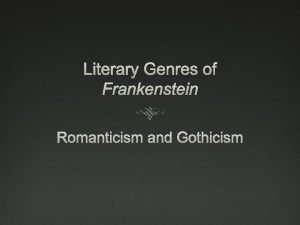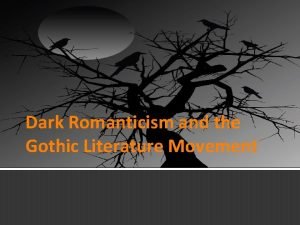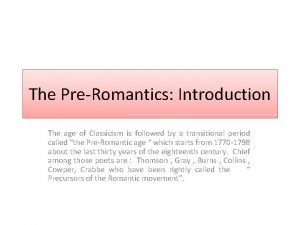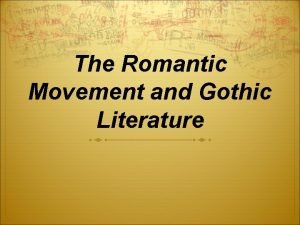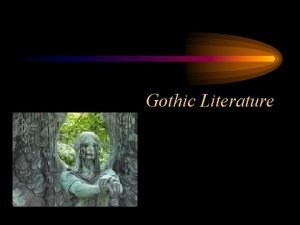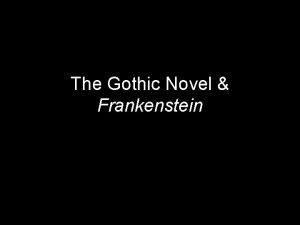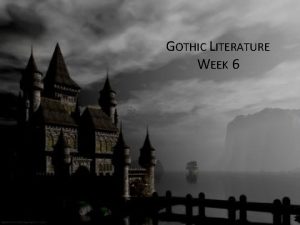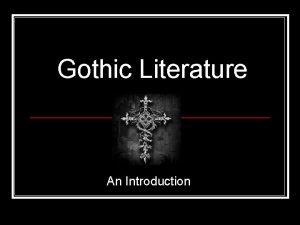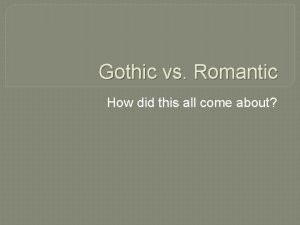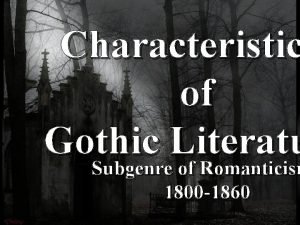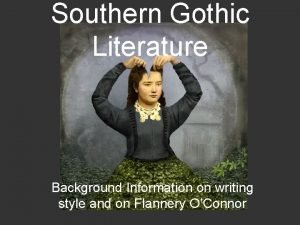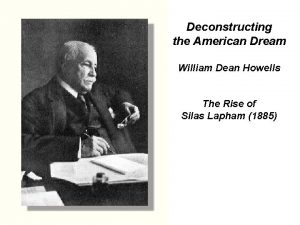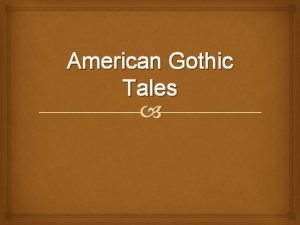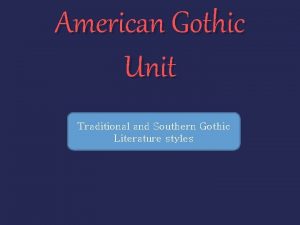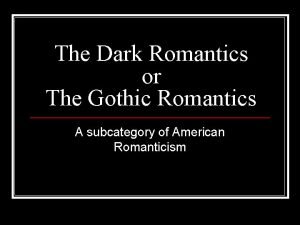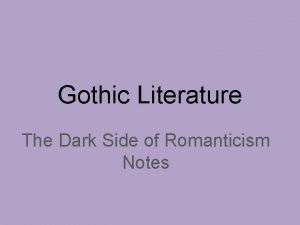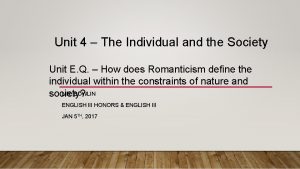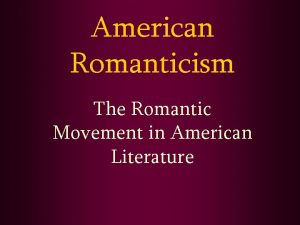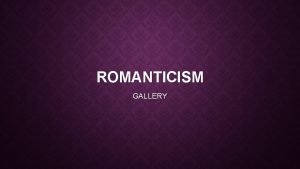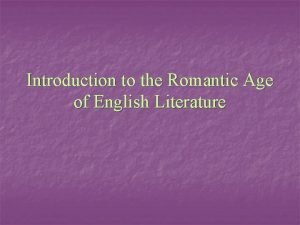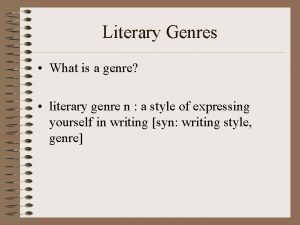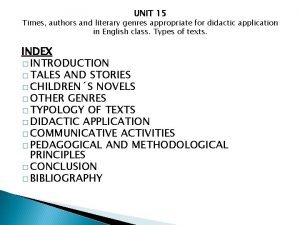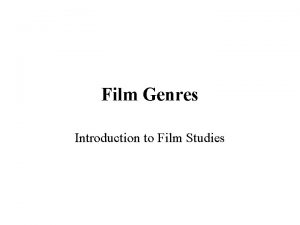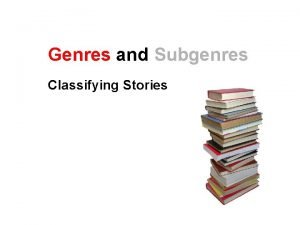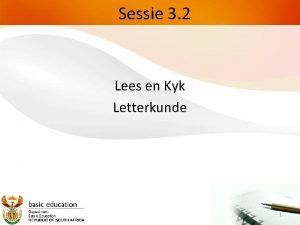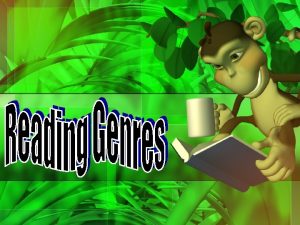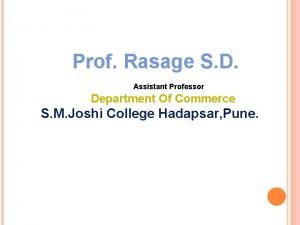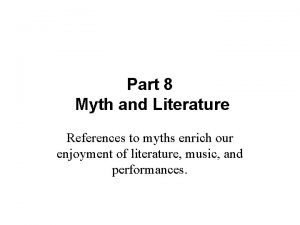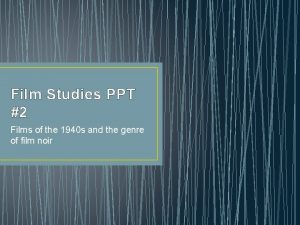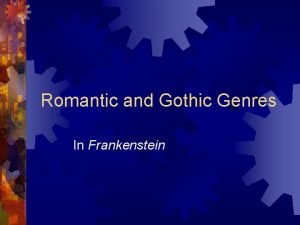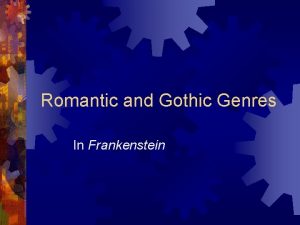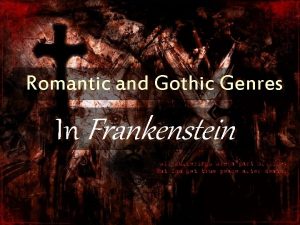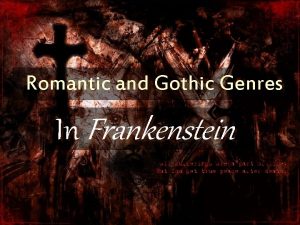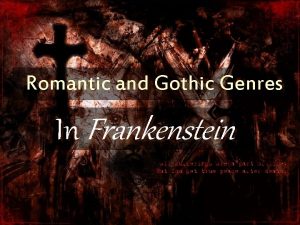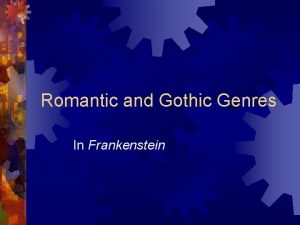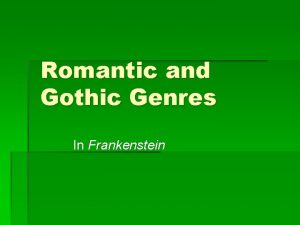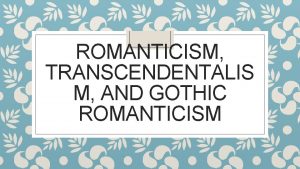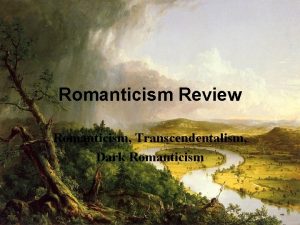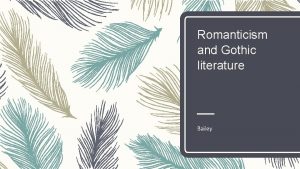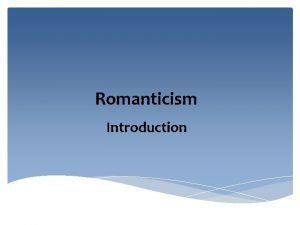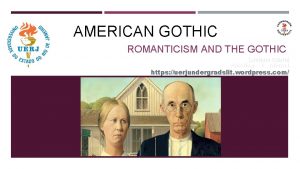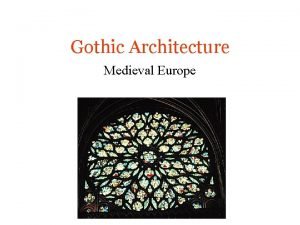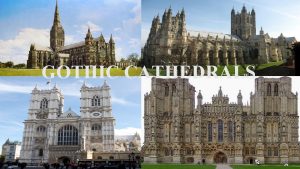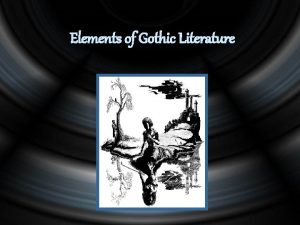Romantic and Gothic Genres Romanticism Definition A movement





































- Slides: 37

Romantic and Gothic Genres

Romanticism Definition: A movement of the eighteenth and nineteenth centuries that marked the reaction in literature, philosophy, art, religion, and politics to the formalism of the preceding forms.

Romanticism ®Victor Hugo called Romanticism “liberalism in literature. ” It freed the artist and writer from restraints and rules. (Hugo- Hunchback of Notre Dame) ®Walter Pater thought the addition of strangeness to beauty defined the Romantic movement. (Pater- English essayist) ®A current definition: a psychological desire to escape from unpleasant realities.

Romanticism Characteristics: ®The predominance of • Individualism imagination over reason and formal rules • Idealization of rural life ®Primitivism • Enthusiasm for the wild, ®Love of nature irregular, or grotesque in nature ®An interest in the past • Enthusiasm for the uncivilized ®Mysticism or “natural”

Romanticism More Characteristics: ®Interest in human rights ®Sentimentality ®Melancholy ®Interest in the gothic

Gothic Literature Definition: A literary style popular during the end of the 18 th century and the beginning of the 19 th. This style usually portrayed fantastic tales dealing with horror, despair, the grotesque and other "dark" subjects.

Gothic Literature Characteristics: ®There is a victim who is helpless against his torturer; there is also a victimizer who is associated with evil and whose powers are immense or supernatural ®The setting of the gothic story is at some point within impenetrable walls (physical or psychological) to heighten the victim's sense of hopeless isolation--the central gothic image is the cathedral or haunted mansion within which the victim is imprisoned

Gothic Literature Characteristics: ® The atmosphere is pervaded by a sense of mystery, darkness, oppressiveness, fear, and doom to recreate the atmosphere of a crypt--a symbol of man's spiritual death and a "vehicle for presenting a picture of man as eternal victim“, and finally, the victim is in some way entranced or fascinated by the inscrutable power of his victimizer.

Gothic Literary Themes Supernatural motifs appear throughout literature but are most prominent in the literary genre labeled "Gothic, " which developed in the late eighteenthcentury and is devoted primarily to stories of horror, the fantastic, and the "darker" supernatural forces. The English Gothic novel originated with the publication of Horace Walpole’s The Castle of Otranto (1765), which Walpole called a "Gothic story. " Frankenstein belongs specifically to the Gothic genre.

® Gothic literature focuses on humanity’s fascination with the grotesque, the unknown, and the frightening, inexplicable aspects of the universe and the human soul. The Gothic "relates the individual to the infinite universe" (Varma 16) and creates horror by portraying human individuals in confrontation with the overwhelming, mysterious, terrifying forces found in the cosmos and within themselves. Gothic literature pictures the human condition as an ambiguous mixture of good and evil powers that cannot be understood completely by human reason. ® Thus, the Gothic perspective conceives of the human condition as a paradox, a dilemma of duality—humans are divided in the conflict between opposing forces in the world and in themselves. ® The Gothic themes of human nature’s depravity, the struggle between good and evil in the human soul, and the existence of unexplainable elements in humanity and the cosmos, are prominent themes in Frankenstein.

Supernatural/Gothic Literary Motifs A motif is a repeated theme, image, or literary device. Look for these common supernatural/Gothic motifs in Frankenstein.

The Double or Doppelganger (German for "double-goer“) Defined by Federick S. Frank as "a second self or alternate identity, sometimes, but not always, a physical twin. The Doppelganger in demonic form can be a reciprocal or lower bestial self or a Mr. Hyde. Gothic doppelgangers often haunt and threaten the rational psyche of the victim to whom they become attached”.

The double motif involves a comparison or contrast between two characters or sets of characters within a work to represent opposing forces in human nature. For example, Dr. Jekyll and his evil double Mr. Hyde are contrasted to represent the battle between the rational, intellectual self (Jekyll) and the irrational, bestial self (Hyde). The double motif suggests that humans are burdened with a dual nature, a soul forever divided. Double characters are often paired in common relationships, such as twins, siblings, husband/wife, parent/child, hero/villain, creator/creature, etc.

Forbidden Knowledge or Power (Faust Motif) Forbidden knowledge/power is often the Gothic protagonist’s goal. The Gothic "hero" questions the universe’s ambiguous nature and tries to comprehend and control those supernatural powers that mortals cannot understand. He tries to overcome human limitations and make himself into a "god. " This ambition usually leads to the hero’s "fall" or destruction; however, Gothic tales of ambition sometimes paradoxically evoke our admiration because they picture individuals with the courage to defy fate and cosmic forces in an attempt to transcend the mundane to the eternal and sublime.

Monster/Satanic Hero/Fallen Man The courageous search forbidden knowledge or power always leads the hero to a fall, a corruption, or destruction, such as Satan’s or Adam’s fall. Consequently, the hero in Gothic literature is often a "villain. " The hero is isolated from others by his fall and either becomes a monster or confronts a monster who is his double. He becomes a "Satanic hero" if, like Satan, he has courageously defied the rules of God’s universe and has tried to transform himself into a god. Note: the mad scientist, who tries to transcend human limitations through science, is a type of Satanic hero that is popular in Gothic literature (examples include Dr. Jekyll and Frankenstein).

Multiple Narrative Spiral Narrative Method The story is frequently told through a series of secret manuscripts or multiple tales, each revealing a deeper secret, so the narrative gradually spirals inward toward the hidden truth. The narrator is often a first-person narrator compelled to tell the story to a fascinated or captive listener (representing the captivating power of forbidden knowledge). By revealing to us their own souls’ secrets, these narrators reveal the secrets of humankind’s soul.

Dreams/Visions Terrible truths are often revealed to characters through dreams or visions. The hidden knowledge of the universe and of human nature emerges through dreams because, when the person sleeps, reason sleeps, and the supernatural, unreasonable world can break through. Dreams in Gothic literature express the dark, unconscious depths of the psyche that are repressed by reasontruths that are too terrible to be comprehended by the conscious mind.

The End

Signs/Omens Reveal the intervention of cosmic forces and often represent psychological or spiritual conflict (e. g. , flashes of lightning and violent storms might parallel some turmoil within a character’s mind).

The End

Gothic Architecture ® Gothic literature derives its name from its similarities to the Gothic medieval cathedrals, which feature a majestic, unrestrained architectural style with often savage or grotesque ornamentation (the word "Gothic" derives from "Goth, " the name of one of the barbaric Germanic tribes that invaded the Roman Empire). ® The vaulting arches and spires of Gothic cathedrals reach wildly to the sky as if the builders were trying to grasp the heavens; and the cathedrals are covered with a profusion of wild carvings depicting humanity in conflict with supernatural forces—demons, angels, gargoyles, and monsters.

Romanticism in Literature Jane Austen, English author (1775 -1817) ® Major Works: ® Sense and Sensibility (1811) ® Pride and Prejudice (1813) ® Emma (1815) ® Continued. . .

Romanticism in Visual Arts ® John Constable, English Romantic Painter (17761837) “No two days are alike, nor even two hours; neither were there ever two leaves of a tree alike since the creation of the world”

Romanticism in Visual Arts ® William Blake, English Poet and Painter (1757 - 1827) ® Whirlwind of Lovers (Illustration to Dante’s Inferno, the Circle of the Lustful)

Romanticism in Music ® Ludwig van Beethoven, Composer (1770 -1827) Austrian Composer ® Student of Haydn ® Deaf through most of his career ® Completed nine symphonies ® Continued. . .

Romanticism in Music ® Frederic Chopin, Composer (1810 -1849) Virtuoso Pianist ® Composed various piano concertos ® Developed a number of new forms of piano music ®

Romanticism in Poetry ® John Keats, English Poet (17951821) Major Works: ® Endymion: A Poetic Romance (1818) ® Hyperion (1820) ® The Eve of St. Agnes (1820) ® Ode to a Nightingale (1820) Continued. . .

Romanticism in Poetry ® Percy Bysshe Shelley, English Poet (1792 -1822) Major Works: ® Prometheus Unbound (1820) ® The Triumph of Life (1824) ® Hymn to Intellectual Beauty (1817)

Romanticism in Poetry ® Samuel Taylor Coleridge, Poet (1772 -1834) Major Works: ® Lyrical Ballads (1798, 1800) ® Kubla Khan (1798) ® Dejection: An Ode (1802) ® Rime of the Ancient Mariner (1798)

® The architecture evokes the sense of humanity’s division between a finite, physical identity and the often terrifying and bizarre forces of the infinite. The Gothic aesthetic also embodies an ambition to transcend earthly human limitations and reach the divine.


Gothic Visual arts ® Giotto di Bondone, Painter (1266 -1377) Continued. . .

Gothic Literature ® Robert Louis Balfour Stevenson, Scottish Novelist (1850 -1894) Major Works: ® Dr. Jekyll and Mr. Hyde (1886) ® Treasure Island(1883) Continued. . .

Gothic Poetry ® ® ® William Wordsworth, English poet (17701850) "The Rime of the Ancient Mariner" by Samuel Taylor Coleridge, English poet (1772 -1834) Lord Byron, English poet (1788 -1824) Percy Bysshe Shelley, English poet (1792 -1822) John Keats, English poet (1795 -1821) Alfred Lord Tennyson, English poet, (1809 -92) Continued. . .

Mary Shelley Born August 30, 1797 ® Mother dies Sept. 9, 1797 ® 1814 Begins a relationship with Percy Shelley. They elope to the continent. ® 1815 First child is born prematurely and dies. ® Continued. . .

Mary Shelley 1816 -19 William and Clara are born and die. ® 1819 Percy Shelley is born. ® 1822 Percy lost at sea. ® 1851 Mary dies at 48. ®

 Gothicism literary definition
Gothicism literary definition Gothic romanticism literature
Gothic romanticism literature Pre romantics
Pre romantics Gothic literature englightenment
Gothic literature englightenment Romanticism is
Romanticism is Gothic traits
Gothic traits The romanticism (1795 — 1835) what is romanticism
The romanticism (1795 — 1835) what is romanticism What is gothic literature definition
What is gothic literature definition Gothic literature define
Gothic literature define Dark romanticism vs gothic
Dark romanticism vs gothic Romanticism vs gothic
Romanticism vs gothic Romanticism vs gothic
Romanticism vs gothic Southern gothic style
Southern gothic style American gothic romanticism
American gothic romanticism American gothic movement
American gothic movement Dark romanticism american gothic unit test
Dark romanticism american gothic unit test Dark romantics
Dark romantics Dark side of romanticism
Dark side of romanticism Romanticism gothic
Romanticism gothic Romantic period in american literature
Romantic period in american literature American romantic movement
American romantic movement Romanticism characteristics
Romanticism characteristics Romantic movement in english literature
Romantic movement in english literature What is a literary genre mean
What is a literary genre mean Movement and non-movement area
Movement and non-movement area Topic 15 periods authors and genres
Topic 15 periods authors and genres Movie genres and subgenres
Movie genres and subgenres Film genres and definitions
Film genres and definitions Genres and subgenres
Genres and subgenres What type of movement
What type of movement Woordkeuse
Woordkeuse Genre
Genre Workplace genres
Workplace genres Title sample of myth
Title sample of myth Traditional story
Traditional story What genre is stranger things
What genre is stranger things Syranger things genre
Syranger things genre Introduction to film studies ppt
Introduction to film studies ppt
